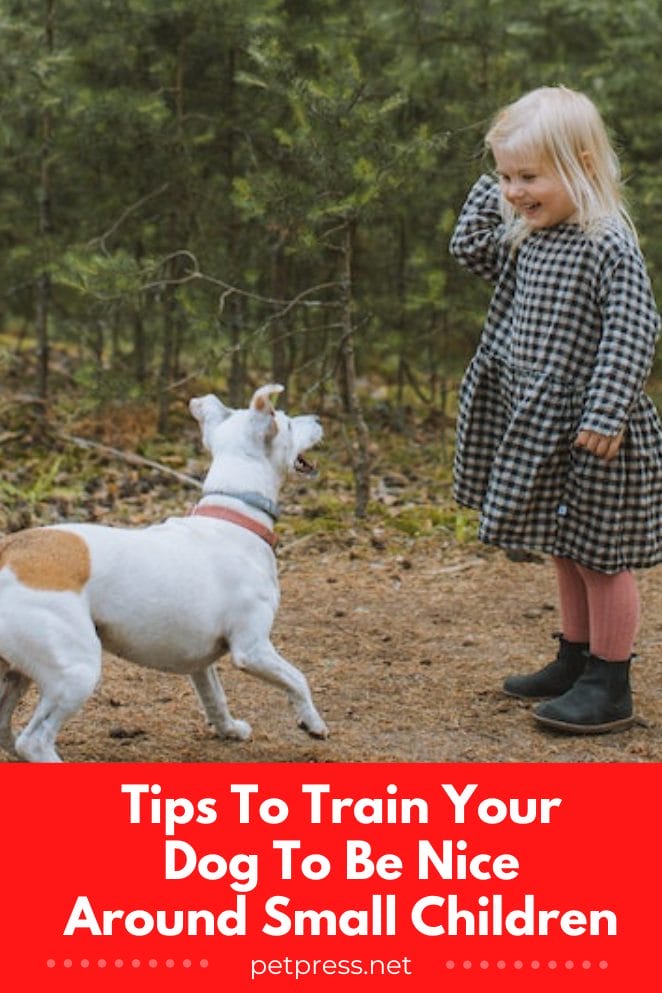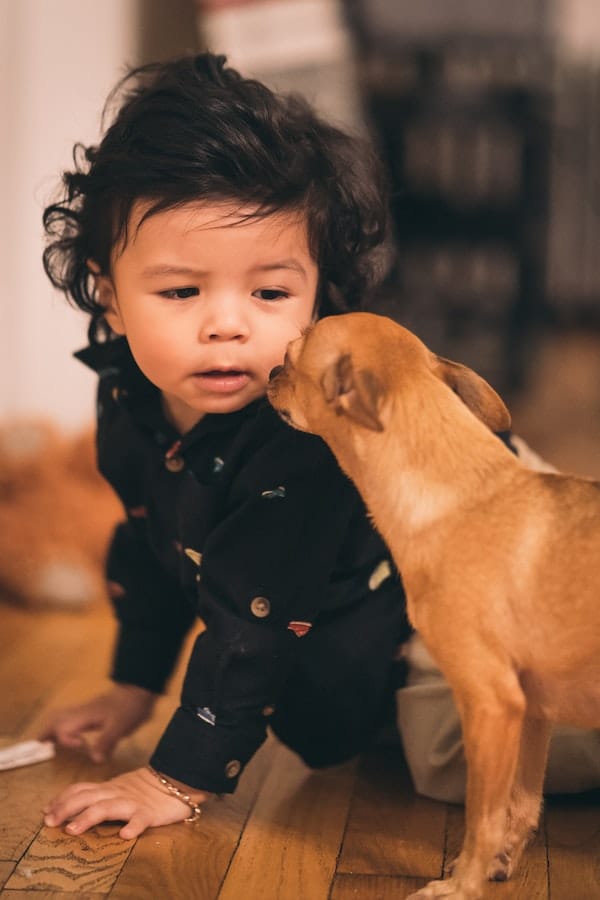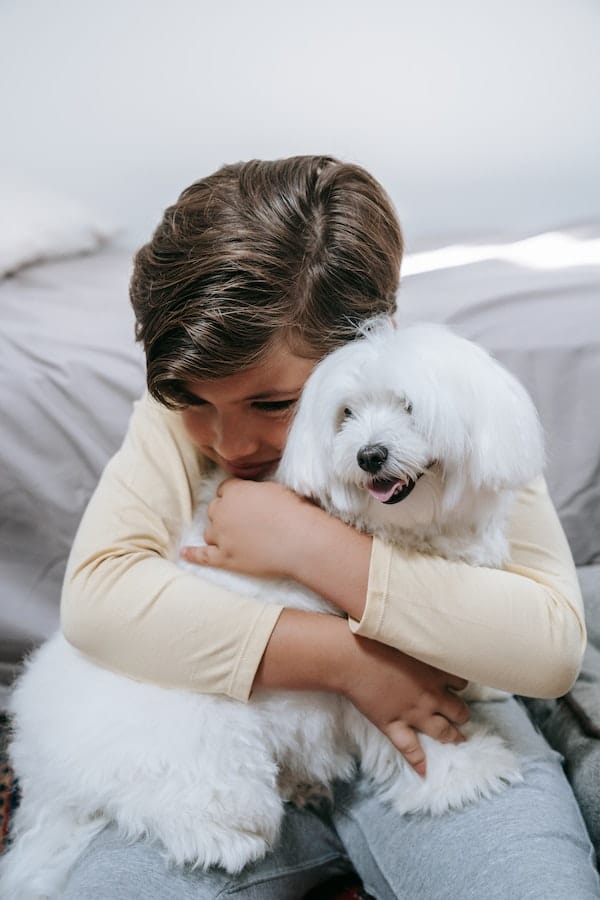
If you have a pet dog and small children in your family, teaching them to coexist harmoniously can be quite a challenge! How do you teach a dog to be nice around small children? It is possible with patience and consistency.
With an understanding of your pup’s body language, setting boundaries, and rewarding good behavior, it is possible for your furry friend to become the perfect playmate for kids.
Read on for more information about how to make sure everyone in your house gets along happily ever after!
How do I get my dog to be nice to kids?

If you want your four-legged friend to be kid-friendly, there are a few important steps that you’ll need to take. Here’s a look at five training tips for teaching your dog to be nice around small children.
First and foremost, it’s important to remember that dogs are not naturally inclined to be gentle with young kids – so keep expectations realistic. That said, there is plenty that can be done with patience and time!
1) Start Early:
As soon as possible, expose your pup to children in a controlled environment like the park or the backyard of an acquaintance who has kids.
Train them constantly on basic commands like “sit” and “stay” when they come into contact with the children so that they can learn to obey even when distractions are present.
2) Make it Positive:
If a child shows an interest in your pooch, be sure to reward good behavior with a treat or verbal praise. This will help them associate being around kids with positive experiences and build trust between them.
3) Keep it Calm:
Children tend to excite dogs more than adults. So if you notice your pup getting overexcited when playing with children, immediately call them off and issue a “calm” command until they settle down.
You may also need to keep the play sessions short at first. Gradually increase their length as the dog becomes more used to the situation.
4) Watch the Kids:
Even if you have trained your pup to be friendly around children, it’s important to keep an eye on any interactions between them.
Young kids may not know how to behave around animals and could inadvertently provoke or hurt the dog, so make sure that all play is supervised.
5) Take a Break:
If at any point your pup starts getting overwhelmed by the presence of children, take them away from the situation for a break before resuming training sessions.
This will help them learn that they can go off and relax when things start feeling too much.
What do you do when your dog doesn’t like small children?

When your dog doesn’t seem to like all the attention from small children, it can be stressful.
Well, don’t despair — there are steps you can take to teach your pup how to behave nicely around tiny humans. Here’s how:
1. Introduce them slowly and calmly
Start by having the child come into view but not too close at first. Praise your dog for remaining calm and give him a treat (or two!) to reinforce good behavior.
Slowly get closer and as soon as you see signs of agitation or discomfort, back off immediately;
2. Provide distractions
Some dogs just need a distraction from the child. If they start getting fussy or aggressive, find something to do with them that will take their mind off the child.
A game of fetch or a long walk around the neighborhood can help to redirect their attention;
3. Set boundaries
If your pup gets too close for comfort, it’s important that you set boundaries right away. Make sure your dog knows where he needs to be. If necessary use a leash or other tool to keep him in check;
4. Reward good behavior
Dogs love rewards, so make sure you provide positive reinforcement when they behave around small children. Praise them when they show patience and give treats as appropriate;
How do you test if a dog is good with children?

If you have a dog and are considering allowing them to spend time around small children, it’s important that they learn how to behave appropriately.
Here are some tips on how to test if your pup is good with kids and teach them the right way to act:
1. Make sure your dog is comfortable in their environment. Have them meet other people, animals, and children in a calm setting before bringing them into contact with little ones.
2. Let your dog get used to the sound of young voices by playing recordings of children talking or laughing at low volumes while they stay relaxed nearby.
3. Get your pup accustomed to handling strangers by having adults (or older children) touch and give treats when appropriate.
4. Have your pup practice basic commands like “sit” and “stay” with people of all ages, so they know how to respond when asked and understand the importance of listening to those in authority.
5. When you feel comfortable enough, let your dog interact with children under close supervision. Make sure the kids are respectful and not overly energetic or loud – this can frighten some dogs!
What age child is best to get a dog?
If you’re considering getting a dog for your child, the best age depends on the breed of dog and the child in question.
Generally speaking, young children may not be ready to handle a pup until they’re at least 5 or 6 years old. It’s also important to consider whether your little one would prefer an older, calmer pet that’s already house-trained.
If so, it might be better to wait until your kid is ready for more responsibility before bringing home a new furry family member.
Ultimately, it’s up to you as a parent to decide what’s best for everyone involved! Just don’t forget: no matter their age, kids should be taught how to properly interact with animals from a young age to ensure everyone’s safety and comfort.
Conclusion
Training your dog to be nice around small children isn’t an easy task, but it can be done. The most important thing is to start early and practice often.
Make sure to reward good behavior with yummy treats or praise, and manage any potential misbehavior with a stern tone of voice. With persistence and consistency, you’ll soon have a pup who loves children as much as they love him!
Remember that you should never leave small children alone with a pet unsupervised – even if the animal appears friendly.
It’s always best to err on the side of caution when it comes to safety. And teaching your dog proper manners around kids will ensure everyone has an enjoyable time together!


GIPHY App Key not set. Please check settings